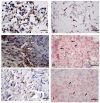Comparison between Colorimetric In Situ Hybridization, Histopathology, and Immunohistochemistry for the Diagnosis of New World Cutaneous Leishmaniasis in Human Skin Samples
- PMID: 36355886
- PMCID: PMC9695648
- DOI: 10.3390/tropicalmed7110344
Comparison between Colorimetric In Situ Hybridization, Histopathology, and Immunohistochemistry for the Diagnosis of New World Cutaneous Leishmaniasis in Human Skin Samples
Abstract
New world cutaneous leishmaniasis (NWCL) is an anthropozoonosis caused by different species of the protozoan Leishmania. Colorimetric in situ hybridization (CISH) was shown to satisfactorily detect amastigote forms of Leishmania spp. in animal tissues, yet it was not tested for the diagnosis of human NWCL. The aim of this study was to compare CISH, histopathology (HP), and immunohistochemistry (IHC) techniques to diagnose NWCL in human cutaneous lesions. The sample comprised fifty formalin-fixed, paraffin-embedded skin biopsy specimens from patients with NWCL caused by L. (V.) braziliensis. These specimens were analyzed by CISH, using a generic probe for Leishmania, IHC, and HP to assess the sensitivity of these methods by using a parasitological culture as a standard reference. Additional specimens from three patients diagnosed with cutaneous mycoses were also included to evaluate cross-reactions between CISH and IHC. The sensitivities of IHC, CISH, and HP for detecting amastigotes was 66%, 54%, and 50%, respectively. IHC, unlike CISH, cross-reacted with different species of fungi. Together, these results demonstrate that CISH may be a complementary assay for the detection of amastigote in the laboratorial diagnosis routine of human NWCL caused by L. (V.) braziliensis.
Keywords: Leishmania braziliensis; diagnosis; immunoperoxidase; in situ hybridization; tegumentary leishmaniasis.
Conflict of interest statement
The authors declare no conflict of interest.
Figures


Similar articles
-
Comparative Study of Colorimetric In Situ Hybridization and Quantitative Real-Time Polymerase Chain Reaction for Diagnosis of Infection by Leishmania infantum in Dogs in Formalin-Fixed and Paraffin-Embedded Skin.Trop Med Infect Dis. 2024 Apr 22;9(4):91. doi: 10.3390/tropicalmed9040091. Trop Med Infect Dis. 2024. PMID: 38668552 Free PMC article.
-
Higher sensitivity of immunohistochemistry for bona fide diagnosis of dog Leishmania (Viannia) braziliensis-driven American tegumentary leishmaniasis: description of an optimized immunohistochemistry method.Trans R Soc Trop Med Hyg. 2015 Jul;109(7):469-76. doi: 10.1093/trstmh/trv034. Epub 2015 May 14. Trans R Soc Trop Med Hyg. 2015. PMID: 25977396
-
Sensitivity and specificity of in situ hybridization for diagnosis of cutaneous infection by Leishmania infantum in dogs.J Clin Microbiol. 2013 Jan;51(1):206-11. doi: 10.1128/JCM.02123-12. Epub 2012 Nov 7. J Clin Microbiol. 2013. PMID: 23135932 Free PMC article.
-
Performance of immunohistochemistry as a useful tool for the diagnosis of cutaneous leishmaniasis in Panama, Central America.Parasitol Int. 2019 Aug;71:46-52. doi: 10.1016/j.parint.2019.03.007. Epub 2019 Mar 16. Parasitol Int. 2019. PMID: 30885795
-
Anti-mitochondrial Tryparedoxin Peroxidase Monoclonal Antibody-Based Immunohistochemistry for Diagnosis of Cutaneous Leishmaniasis.Front Microbiol. 2022 Feb 28;12:790906. doi: 10.3389/fmicb.2021.790906. eCollection 2021. Front Microbiol. 2022. PMID: 35295679 Free PMC article.
Cited by
-
Advancement in Leishmaniasis Diagnosis and Therapeutics.Trop Med Infect Dis. 2023 May 10;8(5):270. doi: 10.3390/tropicalmed8050270. Trop Med Infect Dis. 2023. PMID: 37235318 Free PMC article.
-
Performance of Culture Using a Semi-Automatic Needle as a Novel Tool for Collecting Lymph Node Samples for the Diagnosis of Canine Visceral Leishmaniasis.Animals (Basel). 2025 Jan 5;15(1):107. doi: 10.3390/ani15010107. Animals (Basel). 2025. PMID: 39795050 Free PMC article.
-
The Potential Use of Peptides in the Fight against Chagas Disease and Leishmaniasis.Pharmaceutics. 2024 Feb 4;16(2):227. doi: 10.3390/pharmaceutics16020227. Pharmaceutics. 2024. PMID: 38399281 Free PMC article. Review.
-
Comparative Study of Colorimetric In Situ Hybridization and Quantitative Real-Time Polymerase Chain Reaction for Diagnosis of Infection by Leishmania infantum in Dogs in Formalin-Fixed and Paraffin-Embedded Skin.Trop Med Infect Dis. 2024 Apr 22;9(4):91. doi: 10.3390/tropicalmed9040091. Trop Med Infect Dis. 2024. PMID: 38668552 Free PMC article.
References
-
- Lainson R. Espécies neotropicais de Leishmania: Uma breve revisão histórica sobre sua descoberta, ecologia e taxonomia. Rev. Panamazonica Saude. 2010;1:13–32. doi: 10.5123/S2176-62232010000200002. - DOI
-
- Brazil Ministério da Saúde . Manual de Vigilância da Leishmaniose Tegumentar Americana. 2nd ed. Ministério da Saúde; Brasília, Brazil: 2017.
-
- Pan American Health Organization Leishmaniasis. [(accessed on 26 July 2022)]. Available online: https://www.paho.org/en/topics/leishmaniasis.
-
- Pena H.P., Belo V.S., Xavier-Junior J.C.C., Teixeira-Neto R.G., Melo S.N., Pereira D.A., Fontes I.C., Santos I.M., Lopes V.V., Tafuri W.L., et al. Accuracy of diagnostic tests for American tegumentary leishmaniasis: A systematic literature review with meta-analyses. Trop. Med. Int. Health. 2020;10:168–1181. doi: 10.1111/tmi.13465. - DOI - PubMed
Grants and funding
LinkOut - more resources
Full Text Sources
Research Materials
Miscellaneous

